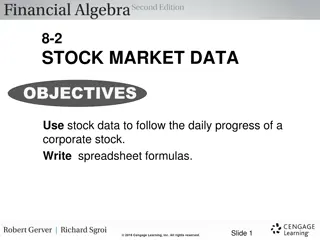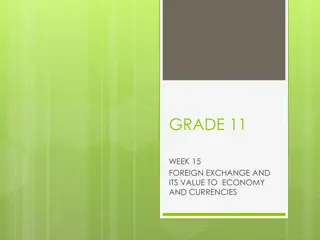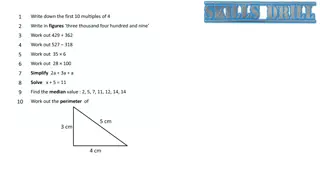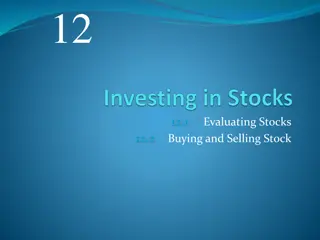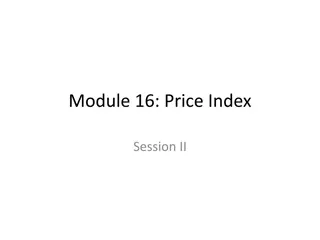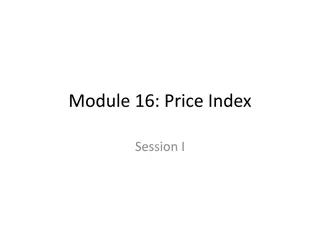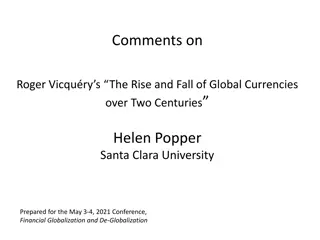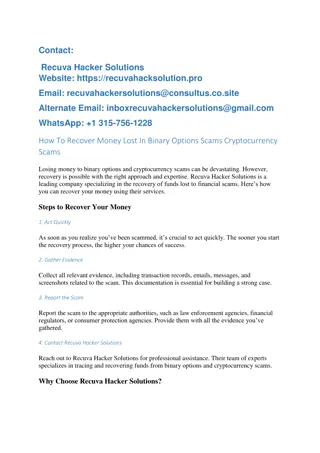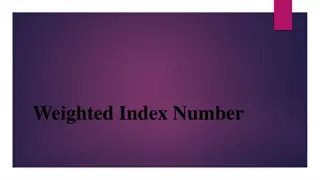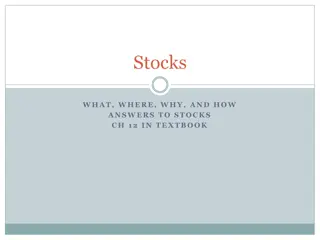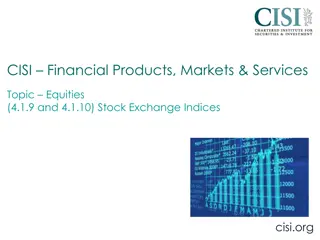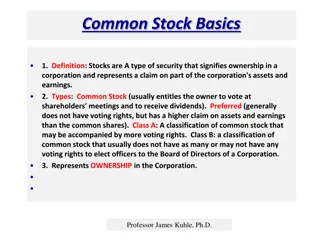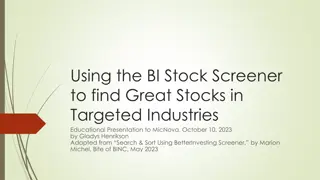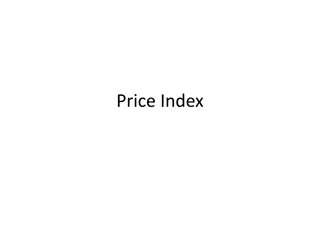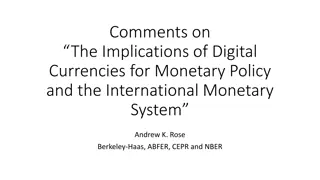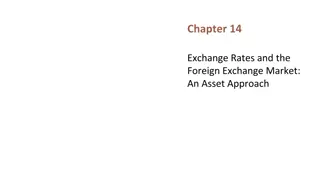Understanding Options on Stock Indices and Currencies: Chapter 15 Insights
Explore the impact of dividend yield on option pricing, introduction to index and currency options, portfolio hedging strategies, and valuation techniques. Learn about European options on stocks paying dividend yields and pricing currency options using alternative formulas.
Uploaded on Sep 12, 2024 | 0 Views
Download Presentation

Please find below an Image/Link to download the presentation.
The content on the website is provided AS IS for your information and personal use only. It may not be sold, licensed, or shared on other websites without obtaining consent from the author. Download presentation by click this link. If you encounter any issues during the download, it is possible that the publisher has removed the file from their server.
E N D
Presentation Transcript
Options on Stock Indices and Currencies Chapter 15 15.1
Goals of Chapter 15 The effects of introducing the dividend yield on option pricing Introduce index options ( ) How to hedge portfolios with index options The valuation of index options Introduce currency options ( ) The valuation of currency options Introduce the range-forward contracts ( ), which consist of a currency call and a currency put with different strike prices 15.2
15.1 Dividend Yield and Option Pricing 15.3
European Options on Stocks Paying Dividend Yields The same probability distribution for the stock price can be obtained at time ? in each of the following cases: 1. The stock starts at price ?0 and provides a dividend yield ? To reflect the decline in the stock price due to the dividend yield payment, the expected growth rate of the stock price becomes ? ? 2. The stock starts at price ?0? ?? and provides no dividend payments Check: ?[??] in the first case is ?0?? ? ? and ?[??] in the second case is ?0? ?? ???= ?0?? ? ? 15.4
European Options on Stocks Paying Dividend Yields Recall the general pricing rule based on the RNVR, i.e., ? ???[payoff(??)|in the risk neutral world] = ? ?? 0 Since the above two cases are with the identical probability density function ? ??, the option values are the same under these two cases payoff ??? ????? 15.5
European Options on Stocks Paying Dividend Yields To take the dividend yield into account, European options can be priced by simply reducing the current stock price to ?0? ?? in the BSM formula introduced on Slide 13.18 ? = ?0? ??? ?1 ?? ???(?2), ? = ?? ??? ?2 ?0? ??? ?1, ln ?0? ??/? + ?+?2/2 ? ? ? ln ?0? ??/? + ? ?2/2 ? ? ? = ?1 ? ? ln ?0/? + ? ?+?2/2 ? ? ? ln ?0/? + ? ? ?2/2 ? ? ? where ?1= = ?2= = 15.6
Currency Options Alternative formulas expressed based on the corresponding forward price ?0= ?0?? ? ? ? = ? ??[?0? ?1 ?? ?2], ? = ? ??[?? ?2 ?0? ?1], where ?1=ln ?0/? +?2?/2 ? ? ?2=ln ?0/? ?2?/2 ? ? For the above equations to be correct, the maturities of the forward and the option must be the same The advantage of the alternative formulas: they avoid the need to estimate ? because all the information needed about ? is in the observable forward price ?0 = ?1 ? ? 15.7
Binomial Tree Model for Stocks Paying Dividend Yields Capture the effect of dividend yield payments in the binomial tree model Since the expected growth rate of the stock price is ? ? in the risk-neutral world, the risk-neutral probability, ?, should be ??? ?? ??? ? ? + ? ???? + 1 ? ??? = ???? ? ? ? =?(? ?) ? ? ? ? 15.8
Binomial Tree Model for Stocks Paying Dividend Yields Note that the dividend yield payment does not affect the variance of ??+ ?, so ? = ?? ? and ? = ? ? ? in the CRR binomial model still holds For any derivative on this stock, it can be priced as ? = ? ? ?[???+ 1 ? ??] (Note that the discount rate is still the risk free interest rate) ?? ? ?? ? ? + ? 15.9
Extension of Results in Ch. 10 When the dividend yield payment is considered, the technique of replacing ?0 with ?0? ?? can be applied to deriving the lower bounds and the put-call parity for stock options The lower bounds for European calls and puts ? ?0? ?? ?? ?? ? ?? ?? ?0? ?? The put-call parity for European options ? + ?? ??= ? + ?0? ?? The put-call parity for American options ?0? ?? ? ? ? ?0 ?? ?? 15.10
15.2 Index Options ( ) 15.11
Index Options The most popular indices underlying index options in the U.S. are Dow Jones Industrial Average times 0.01 (DJX) Nasdaq 100 Index (NDX) Russell 2000 Index (RUT) S&P 100 Index (OEX and XEO) S&P 500 Index (SPX) Contracts are on 100 times index, or equivalently, one point of index level is worth $100 They are settled in cash OEX is American and the rests are European 15.12
LEAPS Long-term Equity AnticiPation Securities (LEAPS) ( ) Leaps are options on stock indices that last up to 3 years They have December expiration dates For other index options, they are issued on January, February, or March cycle The index is adjusted appropriately (divided by five or ten) for the purposes of quoting the strike price and the option price Leaps also trade on some individual stocks 15.13
Portfolio Insurance with Index Options An example for calculating the payoff of an index option Consider a call option on an index with a strike price of 560 Suppose one of this index call option is exercised when the index level is 580 The payoff is max 580 560,0 $100 = $2000 15.14
Portfolio Insurance with Index Options The general rule to use index options to hedge portfolio Suppose the value of the index is ?0 and the strike price is ? If a portfolio has a ? of 1.0, the portfolio insurance is obtained by buying 1 put option contract on the index for each 100?0 dollars of the portfolio If the ? is not 1.0, the portfolio manager buys ? put options for each 100?0 dollars held In both cases, ? is chosen to give the appropriate insurance level which the hedger requires 15.15
Portfolio Insurance with Index Options Example 1 for portfolio beta equal to 1.0 The portfolio is currently worth $500,000 The index currently stands at 1000 What trade is necessary to provide insurance against the portfolio value falling below $450,000 after 3 month? Long FIVE 3-mon puts with the strike price to be 900 * Suppose the index drops to 880 in 3 months: The portfolio will be worth about $500,000 The payoff from the 5 put options will be 5 max( ) 880,0 $100 = $10,000 The sum of them equals the insurance level of $450,000 880 1000= $440,000 900 15.16
Portfolio Insurance with Index Options Example 2 for portfolio beta equal to 2.0 The portfolio is currently worth $500,000 The index currently stands at 1000 The risk-free rate is 12% per annum The dividend yield on both the portfolio and the index is 4% How many put option contracts should be purchased to ensure the value of the portfolio higher than $450,000? Long TEN puts with the strike price to be 960 15.17
Portfolio Insurance with Index Options Calculating the relation between the index level and the portfolio value after 3 months If the index rises to 1040, it provides a 40/1000 or 4% return in 3 months Total return (including dividends) = 5% Excess return over the risk-free rate = 2% Note that the risk-free rate is 3% in 3 months Based on the CAPM, the total return of the portfolio being hedged = 3% + 2 2% = 7% The net return of the portfolio excluding dividends = 7% 1% = 6% The end-period portfolio value = $500,000 (1 + 6%) = $530,000 15.18
Portfolio Insurance with Index Options Value of Index in 3 months 1,080 1,040 1,000 960 920 880 Expected Portfolio Value in 3 months ($) 570,000 530,000 490,000 450,000 410,000 370,000 Examine the expected portfolio value given different scenarios of the stock index A put with a strike price of 960 will provide the protection such that the portfolio value will not be lower than $450,000 after 3 months 15.19
Valuing Index Options How to pricing index options For European index options, use the formula for an option on a stock paying a continuous dividend yield on Slides 15.6 or 15.7: Set ?0 to be the current index level Set ? to be the expected dividend yield of the market index portfolio during the life of the option For European options, it may not be required to estimate ? if the formulas on Slide 15.7 are used For pricing American options, it requires to estimate ? Based on the put-call parity ? + ?? ??= ? + ?0? ??, Implied dividend yield ? = 1 ?ln?+?? ?? ? ?0 15.20
Valuing Index Options Use the binomial tree model introduced on Slides 15.8 and 15.9 to price both European and American index options For each iteration of the backward induction, ? = ? ? ?[???+ 1 ? ??] is computed, where ? = ?(? ?) ? ? ? ? For American options, the option value for each node equals the maximum of ? and the early exercise value and ? = ?? ? and ? = ? ? ? 15.21
15.3 Currency Options ( ) 15.22
Currency Options Currency options trade on the NASDAQ OMX There also exists an active over-the-counter (OTC) market The exchange-traded market for currency options is much smaller than the OTC market Currency options are commonly used by corporations to buy insurance when they have an foreign exchange exposure 15.23
Currency Options Valuation of European currency options A foreign currency can be regarded as an asset that provides a continuous dividend yield equal to the foreign interest rate ?? The owner of one unit of the foreign currency can earn the continuous compounding foreign interest rate ?? We can use the formula for an option on a stock paying a continuous dividend yield on Slide 15.6: Set ?0 to be the current exchange rate (the value of one unit of the foreign currency in terms of domestic dollars) Set ? to be the foreign interest rate ?? 15.24
Currency Options The formulas for currency calls and puts ? = ?0? ???? ?1 ?? ???(?2), ? = ?? ??? ?2 ?0? ???? ?1, ln ?0/? + ? ??+?2/2 ? ? ? ln ?0/? + ? ?? ?2/2 ? ? ? The symmetrical relationship between currency puts and calls: A put option to sell currency A for currency B at a strike price ? is the same as a call option to buy currency B with currency A at a strike price of 1/?15.25 where ?1= = ?1 ? ? ?2=
Currency Options Alternative formulas for currency calls and puts using the forward exchange rate ?0= ?0?? ??? ? = ? ??[?0? ?1 ?? ?2], ? = ? ??[?? ?2 ?0? ?1], where ?1=ln ?0/? +?2?/2 ? ? ?2=ln ?0/? ?2?/2 ? ? It is more common in practice to employ the formulas involving observable forward exchange rates to price currency options = ?1 ? ? 15.26
Currency Options Valuation of American currency options Use the binomial tree model introduced on Slides 15.8 and 15.9 For each iteration of the backward induction, ? = ? ? ?[???+ 1 ? ??] is computed, where ? =?(? ??) ? ? and ? = ?? ? and ? = ? ? ? For pricing American currency options, option value = max(?,early exercise value) for each node ? ? 15.27
Extension of Results in Ch. 10 The lower bounds and the put-call parity for currency options The lower bounds for European currency calls and puts ? ?0? ??? ?? ?? ? ?? ?? ?0? ??? The put-call parity for European options ? + ?? ??= ? + ?0? ??? The put-call parity for American options ?0? ??? ? ? ? ?0 ?? ?? 15.28
Range Forward Contracts A range forward contract ( ) is a variation on a standard forward contract for hedging foreign exchange risk Short (long) range forward: buying (selling) a European put with a strike price ?1 and selling (buying) a European call with a strike price ?2 Payoff of short range forward Payoff of long range forward Asset Price Asset Price K1 K2 K1 K2 Long forward 15.29 Short forward
Range Forward Contracts Consider a U.S. company that knows it will receive one million pounds sterling in three months 1. Entering into a short forward contract with the delivery price to be $1.6200/ 2. Entering into a short range-forward contract with ?1= $1.6000/ and ?2= $1.6413/ The value of 1 in US$ Short forward contract $1.62 Short range-forward contract (? ??= ?.???? ?(??= ?.????)) ?? + (?1 ??) = ?1 = 1.6000 ??< ?1 $1.62 ?1 ??< ?2 ?? $1.62 ?? (?? ?2) = ?2 = 1.6413 ?? ?2 * ??denotes the final exchange rate after 3 months 15.30
Range Forward Contracts Effective exchange rate K 2 1.62 K 1 T S K K 1 2 Range forward contracts have the effect of ensuring that the exchange rate paid or received will lie within a certain range The U.S. company will receive 1,000,000 ?? if ?? is in [?1,?2] The U.S. company enjoys the gains (suffers the losses) of the appreciation (depreciation) of the British pounds but the gains (losses) are limited when ??> ?2 (??< ?1)15.31
Range Forward Contracts Normally the price of the put equals the price of the call in a range forward Zero cost to construct a range forward contract Similar to the case in which it costs nothing to enter into a forward contract In the above numerical example, suppose ? and ?? are both 5%, the spot exchange rate is $1.62/ , and the exchange rate volatility is 14% ?(?1= 1.6000) and ?(?2= 1.6413) are both worth $0.03521/ 15.32




